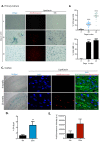Cortical neurons develop a senescence-like phenotype promoted by dysfunctional autophagy
- PMID: 31469660
- PMCID: PMC6738425
- DOI: 10.18632/aging.102181
Cortical neurons develop a senescence-like phenotype promoted by dysfunctional autophagy
Abstract
Senescent cells accumulate in various tissues and organs with aging altering surrounding tissue due to an active secretome, and at least in mice their elimination extends healthy lifespan and ameliorates several chronic diseases. Whether all cell types senesce, including post-mitotic cells, has been poorly described mainly because cellular senescence was defined as a permanent cell cycle arrest. Nevertheless, neurons with features of senescence have been described in old rodent and human brains. In this study we characterized an in vitro model useful to study the molecular basis of senescence of primary rat cortical cells that recapitulates senescent features described in brain aging. We found that in long-term cultures, rat primary cortical neurons displayed features of cellular senescence before glial cells did, and developed a functional senescence-associated secretory phenotype able to induce paracrine premature senescence of mouse embryonic fibroblasts but proliferation of rat glial cells. Functional autophagy seems to prevent neuronal senescence, as we observed an autophagic flux reduction in senescent neurons both in vitro and in vivo, and autophagy impairment induced cortical cell senescence while autophagy stimulation inhibited it. Our findings suggest that aging-associated dysfunctional autophagy contributes to senescence transition also in neuronal cells.
Keywords: SASP (senescence-associated secretory phenotype); autophagy; brain; neuron; senescence.
Conflict of interest statement
Figures









References
-
- Acosta JC, Banito A, Wuestefeld T, Georgilis A, Janich P, Morton JP, Athineos D, Kang TW, Lasitschka F, Andrulis M, Pascual G, Morris KJ, Khan S, et al. A complex secretory program orchestrated by the inflammasome controls paracrine senescence. Nat Cell Biol. 2013; 15:978–90. 10.1038/ncb2784 - DOI - PMC - PubMed
Publication types
MeSH terms
LinkOut - more resources
Full Text Sources

